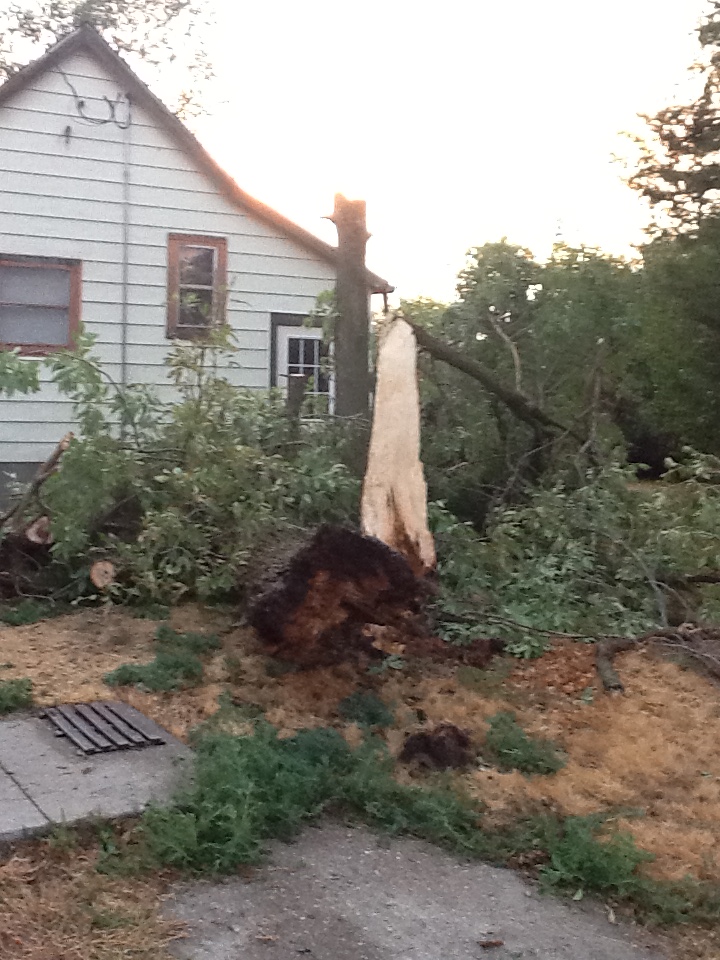The recent storms and severe weather have wreaked havoc all across Nebraska. It’s a good reminder to have a severe weather plan in place, not just for us, but also for your trees. Take advantage of the opportunity to scout for potential issues in your landscape trees.
It is unavoidable that there will be some storm damage to trees at some point in time. Strong winds can cause damage to trees that is evident immediately, but some damage to trees won’t be noticed for years down the road. The Nebraska Forest Service has a few tips for homeowners who are caring for storm damaged trees:
- Safety at all times. Use caution around trees during and after extreme weather. Falling limbs and debris may be hazards long after the storm has passed.
- Inspect the trees for splits or cracks in the trunk. This might indicate a structural problem with the tree. If you think a tree has sustained structural damage, contact an arborist.
- Never climb a damaged tree to remove limbs or attempt clean up on a tree that is leaning.
- Be wary of individuals who go door-to-door to get your business following a storm, use a local reputable service.
- Pass on offers to top your tree. Topping harms the tree and increases the likelihood of structural problems and the trees recovery time after a storm.
- Check the whole tree before pruning. First remove any dead, diseased, or broken branches that can easily be reached from the ground.
If more than 50% of the tree’s branches need to be removed due to storm damage, consult an arborist and consider removing the tree.
Be sure to have the correct pruning information from a reputable source. If you are dealing with large trees or trees with significant storm damage, contact a certified arborist. Don’t know who is a certified arborist in the area? Both the Nebraska Arborist Association and the International Society of Arboriculture’s webpages offer ‘find arborists’ searches for lists of certified arborists in your area. Certified arborists have additional certification and training related to the health and care of trees.
If you are able to do the pruning yourself, make sure you are pruning properly AND safely. Anything dead, damaged, or diseased, can be removed at any time. Make a clean pruning cut just outside the branch collar near the trunk of the tree or at the next branch union (depending on the size of the broken limb). The Nebraska Forest Service has multiple publications that deal with all tree related topics, even pruning storm damaged trees. This information can be found at https://nfs.unl.edu/publications/immediate-care-storm-damaged-trees.
Using the proper tools ensures a clean cut and wounds that heal quickly. There are two main pruner types, by-pass and anvil. By-pass pruners work like a pair of scissors, with the sharp blade by-passing the stationary blade. Anvil pruners have a blade that closes down on a flat edge. They have an action that is similar to a knife against a cutting board. When pruning small branches, those that are 1” in diameter or smaller, hand pruners are recommended. The by-pass pruners offer a cleaner cut. Often the anvil pruners can crush the branches, but use what you have to remove the damaged branches. If you have to twist the pruners or take multiple ‘bites’ at the branch, a different tool is needed. For branches that have a diameter greater than 1”, loppers are recommended. Pruning saws are extremely sharp and work well to get into the tight places that the pruners and loppers don’t fit. They can also cut branches that are larger than 1.5” in diameter. The last tool is hedge shears. They are used for shearing hedges or shaping plants and shouldn’t be used as substitutes for other pruning equipment.
Take advantage of the warm weather and do a little scouting in your landscape. With proper care and maintenance, severe storms don’t have to spell disaster for your trees.
Elizabeth Exstrom is the Horticulture Extension Educator with Nebraska Extension in Hall County. For more information contact Elizabeth at elizabeth.exstrom@unl.edu, her blog at https://huskerhort.com/, or HuskerHort on Facebook and Twitter.

